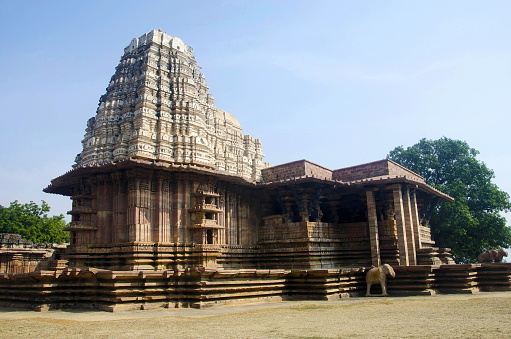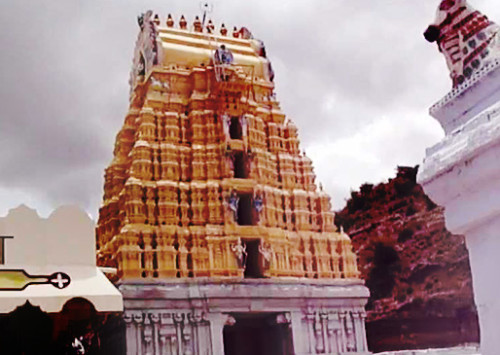Ramappa temple: Telangana’s first UNESCO World Heritage Site
About 200 km north-east of Hyderabad, capital of Telangana, in the village of Palampet, stands a marvel of Indian history, the Ramappa temple, which is also known as Rudreshswara temple. This medieval wonder dates back to 1213 AD and was built by the Kakatiya ruler Kakati Ganapati Deva, but the temple is named after its chief architect, Ramappa, making it perhaps the only temple in India to be known by the name of its sculptor. It took almost over 40 years to construct the temple.
On June 25, 2021, the United Educational, Scientific and Cultural Organization (UNESCO) declared the Ramappa temple as a World Heritage Site, making it the 40th such site in India.
The Ramappa temple is built on 2-metre high star shaped platform and its walls, pillars and ceilings are decorated adorned with intricate carvings, displaying the mastery of the Kakatiya sculptors. They also used unique techniques to build it. For instance, one of the main reasons for the temple to be accorded the UNESCO tag was that it was built with the sandbox technique.
This technique was quite unique to Kakatiya dynasty and was also used by Kakatiya rulers for construction of another renowned temple in the region, the Thousand Pillar Temple in Warangal. This technique has protected the structure from destruction, even in case of an earthquake as the temple withstood a major earthquake in the 17th century, and yet emerged largely unscathed. Due to earthquake, the floor base of Ramappa temple (plinth beams) popped out from the ground, leading to cracks in some sculptures.
The main structure of the temple was built in red sandstone, while the temple’s decorated beams and pillars are carved in granite with a distinctive and pyramidal Vinama (horizontally tower) which is made of lightweight porous bricks. The most mesmerising feature of the temple is that it is built with the bricks that are so light that they can be easily float on water.
“Architects of ancient Indian temples had a unique way of blending art and science, to create a magical effect ancient India was far more developed than we thought,” Mengaram Bharadwaja, a 23-year-old student from Hyderabad, tells Media India Group.
Also Read – The ruins of Purulia temples.
Unusual Indian temples with their offbeat offerings.
“The more I visit ancient temples, which were build many centuries ago, it makes me more enchanted. Every small sculpture was moulded in a unique way and today in a modern world this may be something easy to do, but how they did without any technology at that time, that’s still a question for me. The pillars of the temple are beautifully decorated, in an incredible way,” Bharadwaja adds.
Features of the temple
The presiding deity in Ramappa temple is Ramalingeswara Swamy, a form of Lord Shiva and the Shiva Lingam inside sanctum sanctorum of the temple is about 3 metres in height. The walls of the temple are carved with scenes from both the Hindu epics, the Ramayana and the Shiva Purana, recounting tales of Lord Shiva and displaying the activities of ancient times.
The key attraction in this temple are the shining black idols known as Madhanikas, there are total 12 statues around the temple. “I cannot imagine how they managed to make these beautiful statues, using only their old tools. The more I gazed on an idol, the more amazed it left me,” says Bharadwaja.
Indeed, to be tagged as a World Heritage Site by UNESCO, a monument has to leave its visitors awestruck. According to the UNESCO, a monument gets a recognised as a heritage site when it has an “outstanding universal value and represents a masterpiece of human creative genius.”
One of the most striking things about the sculptures carved here is the optical illusions they create. For instance, in one carving one can see torsos of three dancers, but only four legs. If one moves to see the carving from another angle, one can see two girls with four legs, but from another angle, the view changes again.
“I was left mesmerised by the 3D effects in the sculptures in the temple. They are actually quite small, but many of the sculptures have a 3D effect. For instance, I saw a sculpture of group of dancers and their legs were carved like actual legs and it seemed there was space behind them, so when I tried to put my finger there, of course there was no space. I have never seen anything so amazing anywhere else,” Bharadwaja tells Media India Group.
It is not just youngsters like Bharadwaja or today’s tourists who have been left awe-struck by the Ramappa temple. Centuries earlier, European merchants and travellers were also left equally mesmerised by the beauty of the temple. The famous explorer Marco Polo remarked that the temple was the “brighest star among the galaxy of temples of South India” during his visit to India and the Kakatiyan Empire during 13th century.
Also Read – Nepal: Tales from Temples, Peaks & Valleys.
Karnataka excited about Hoysala Temples World Heritage nomination.
Another wonderful sculpture is a musical pillar with a carving of Lord Krishna that can be seen playing his flute, while standing under a tree. On tapping the idol of the Lord, the sounds of Saptaswaras (Sa Re Ga Ma Pa Dha Ni Sa), that denote the seven notes of Indian music, can be heard.
“Outside the temple, there are many carvings from ancient wrestling fights, that showed various types of locks and position, which means these sports existed in India at least 800 years ago. There were plenty of carvings which showed the activities that were carried out around the temple at the epoch,” Bharadwaja adds.













